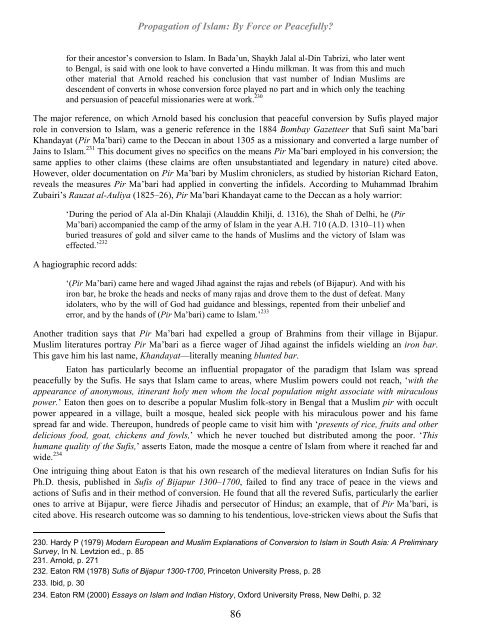islamic-jihad-legacy-of-forced-conversion-imperialism-slavery
islamic-jihad-legacy-of-forced-conversion-imperialism-slavery
islamic-jihad-legacy-of-forced-conversion-imperialism-slavery
- No tags were found...
Create successful ePaper yourself
Turn your PDF publications into a flip-book with our unique Google optimized e-Paper software.
Propagation <strong>of</strong> Islam: By Force or Peacefully?for their ancestor’s <strong>conversion</strong> to Islam. In Bada’un, Shaykh Jalal al-Din Tabrizi, who later wentto Bengal, is said with one look to have converted a Hindu milkman. It was from this and muchother material that Arnold reached his conclusion that vast number <strong>of</strong> Indian Muslims aredescendent <strong>of</strong> converts in whose <strong>conversion</strong> force played no part and in which only the teachingand persuasion <strong>of</strong> peaceful missionaries were at work. 230The major reference, on which Arnold based his conclusion that peaceful <strong>conversion</strong> by Sufis played majorrole in <strong>conversion</strong> to Islam, was a generic reference in the 1884 Bombay Gazetteer that Sufi saint Ma’bariKhandayat (Pir Ma’bari) came to the Deccan in about 1305 as a missionary and converted a large number <strong>of</strong>Jains to Islam. 231 This document gives no specifics on the means Pir Ma’bari employed in his <strong>conversion</strong>; thesame applies to other claims (these claims are <strong>of</strong>ten unsubstantiated and legendary in nature) cited above.However, older documentation on Pir Ma’bari by Muslim chroniclers, as studied by historian Richard Eaton,reveals the measures Pir Ma’bari had applied in converting the infidels. According to Muhammad IbrahimZubairi’s Rauzat al-Auliya (1825–26), Pir Ma’bari Khandayat came to the Deccan as a holy warrior:‘During the period <strong>of</strong> Ala al-Din Khalaji (Alauddin Khilji, d. 1316), the Shah <strong>of</strong> Delhi, he (PirMa’bari) accompanied the camp <strong>of</strong> the army <strong>of</strong> Islam in the year A.H. 710 (A.D. 1310–11) whenburied treasures <strong>of</strong> gold and silver came to the hands <strong>of</strong> Muslims and the victory <strong>of</strong> Islam waseffected.’ 232A hagiographic record adds:‘(Pir Ma’bari) came here and waged Jihad against the rajas and rebels (<strong>of</strong> Bijapur). And with hisiron bar, he broke the heads and necks <strong>of</strong> many rajas and drove them to the dust <strong>of</strong> defeat. Manyidolaters, who by the will <strong>of</strong> God had guidance and blessings, repented from their unbelief anderror, and by the hands <strong>of</strong> (Pir Ma’bari) came to Islam.’ 233Another tradition says that Pir Ma’bari had expelled a group <strong>of</strong> Brahmins from their village in Bijapur.Muslim literatures portray Pir Ma’bari as a fierce wager <strong>of</strong> Jihad against the infidels wielding an iron bar.This gave him his last name, Khandayat—literally meaning blunted bar.Eaton has particularly become an influential propagator <strong>of</strong> the paradigm that Islam was spreadpeacefully by the Sufis. He says that Islam came to areas, where Muslim powers could not reach, ‘with theappearance <strong>of</strong> anonymous, itinerant holy men whom the local population might associate with miraculouspower.’ Eaton then goes on to describe a popular Muslim folk-story in Bengal that a Muslim pir with occultpower appeared in a village, built a mosque, healed sick people with his miraculous power and his famespread far and wide. Thereupon, hundreds <strong>of</strong> people came to visit him with ‘presents <strong>of</strong> rice, fruits and otherdelicious food, goat, chickens and fowls,’ which he never touched but distributed among the poor. ‘Thishumane quality <strong>of</strong> the Sufis,’ asserts Eaton, made the mosque a centre <strong>of</strong> Islam from where it reached far andwide. 234One intriguing thing about Eaton is that his own research <strong>of</strong> the medieval literatures on Indian Sufis for hisPh.D. thesis, published in Sufis <strong>of</strong> Bijapur 1300–1700, failed to find any trace <strong>of</strong> peace in the views andactions <strong>of</strong> Sufis and in their method <strong>of</strong> <strong>conversion</strong>. He found that all the revered Sufis, particularly the earlierones to arrive at Bijapur, were fierce Jihadis and persecutor <strong>of</strong> Hindus; an example, that <strong>of</strong> Pir Ma’bari, iscited above. His research outcome was so damning to his tendentious, love-stricken views about the Sufis that230. Hardy P (1979) Modern European and Muslim Explanations <strong>of</strong> Conversion to Islam in South Asia: A PreliminarySurvey, In N. Levtzion ed., p. 85231. Arnold, p. 271232. Eaton RM (1978) Sufis <strong>of</strong> Bijapur 1300-1700, Princeton University Press, p. 28233. Ibid, p. 30234. Eaton RM (2000) Essays on Islam and Indian History, Oxford University Press, New Delhi, p. 3286


